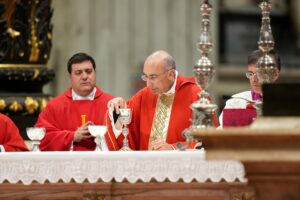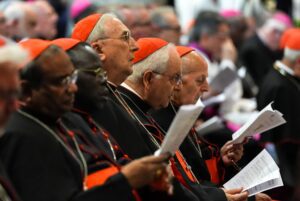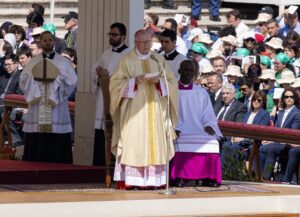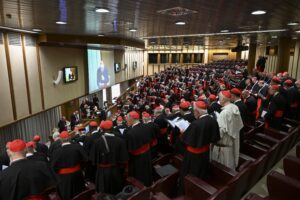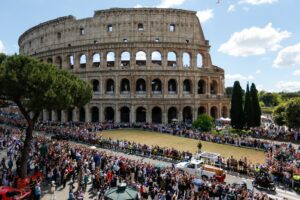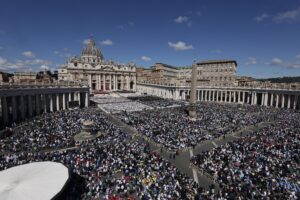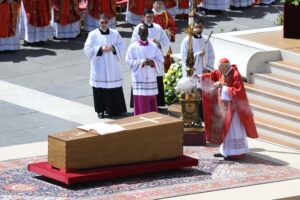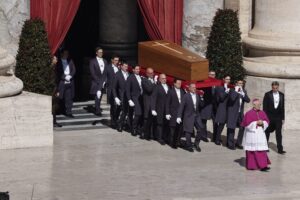ROME (OSV News) – In a mix of joy, excitement and sadness, families, associations and individuals from all over the world celebrated the Jubilee of People with Disabilities with Mass April 28 in Rome’s Basilica of St. Paul Outside the Walls.
Joy reverberated inside the basilica. Sadness was felt too, because instead of meeting the pope in person, the people with disabilities who flocked to Rome had to say goodbye to the pontiff who reached out to those often excluded from society.
Giusi, from Sicily, mother of Sofia and Andrea Joel, a boy with autism, and wife of Maurizio, told OSV News they booked the trip months ago and that it was a “very special moment intertwined with the papal funeral.”
There was “a lot of emotion, a lot of joy, a lot of sadness, too, because we lost our pontiff, but we have hope and faith for the new one to lead the faithful,” said Giusi, who only gave her first name.
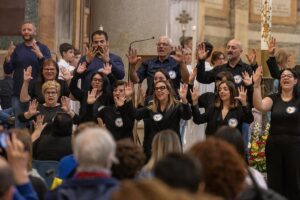
“Celebrating the Jubilee, we’re just grateful for the life of our son, because of course there are a million challenges for our family, but we find strength to come forward,” she said. “We’re really happy with this pilgrimage – we’re tired but it’s beautiful.”
Grace Arnold, who is 19, came with her mom, Patricia, from Kansas City. “I’m really excited about this pilgrimage,” she said. “I wanted to know more about the church. To be here with mom, to be bonding with her, it’s amazing,” she said.
Grace, who has Down syndrome, said that going through the Holy Door at St. Paul Outside the Walls was “very cool” and while it was a “little sad initially” for her to hear that Pope Francis died, she is “really excited now that we can be praying for the new one.”
“I wanted for my daughter to have a sense of the global church, and to understand that she’s not alone,” Grace’s mother, Patricia, told OSV News.
“The Christian community first prays,” said Archbishop Rino Fisichella, organizer of the Jubilee 2025 events and pro-prefect of the Dicastery for Evangelization under Pope Francis.
Prayer “is our salvation,” he told the packed basilica.
The first prayer, Archbishop Fisichella said, is to “ask the Lord for the courage not to remain silent, the courage to always proclaim that Christ is risen.”
Speaking to many people with disabilities who came with their caregivers, Archbishop Fisichella said: “Let us remember that we always have a community to refer to, our little church.”
For Irene Verzeletti from Brescia, near Milan in northern Italy, this sense of community is really important. She is part of the apostolate of blind people, and she said the association keeps reminding society that “blind people — we can work, we can do things, we can graduate, we can study, we can do all that people that see can do.” The 48-year-old is an accountant at the University of Brescia.
The Jubilee for her is important, because “we are here to pray together,” and remember that “the person we have around can be a real friend. And not only people who take care of us. Everyone can exchange their gifts like it is written in the Gospel, I can give you my talent, and you can give me yours,” Verzeletti said.
American Catholic journalist JD Flynn, who was with his wife, said several months ago they “felt sort of a call to come to the Jubilee for People with Disabilities.” Thanks to the generosity of sponsors, they brought four other families “from all over the U.S.” to Rome and, who – like the Flynn’s – have children with Down syndrome.
“It’s been a gift to come together and pray together. I think it was a gift to be at this Mass,” Flynn said.
“People with disabilities don’t always experience that. Sometimes they experience the church as their home. But as often as not, they experience marginalization in the church or isolation in the church, not necessarily by malice, but just a failure to appreciate the kinds of accommodations that they need,” Flynn, father of three, told OSV News.
“Pope Francis said a few years ago: ‘The church is your home.’ It was a call for all of us Catholics, to exercise the Lord’s preferential love for the poor — by exercising the Lord’s preferential love for people with disabilities,” he said. “And it’s been beautiful to see that play out in the life of the church over the past couple of years. It’s been beautiful to see that play out in the life of our own family in the past couple years.”
He added: “It can be hard to be a family of someone with disabilities, and it can be a gift to have the church say: ‘We love you and we want to share with you in your joys and sufferings as God says so.'”
Tomasz Sitarz from Lodz, Poland, came for the Jubilee with his son, Peter, who is hard of hearing.
“My hope is that society understands the needs of the disabled people. Sometimes we don’t need certain help, we need true support in our children’s needs, because the world is putting obstacles under their feet, and we want the world simply to support us.”
His fellow Pole Ewa Majewska, who lives in Hamburg, Germany, gave up her holidays to volunteer for the Jubilee.
Asked about her experience, she immediately teared up and said: “I can’t even tell you how many graces I felt here, and the Jubilee of People with Disabilities is just a highlight of the week, in which I saw the pope for the first time in my life on Easter Sunday and then I said goodbye to him just a day later.”
Verzeletti was especially excited to go through the Holy Door with her 3-year-old guide dog, Berto.
“This door is like magic, because when you pass through this door, you can express your desires, your wishes, you can wish and pray.”
She said she didn’t pray for or wish to see again. “I was born blind, I don’t know anything else,” she said.
“My greatest wish is to find love, a great person to love.”

